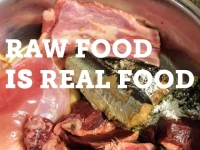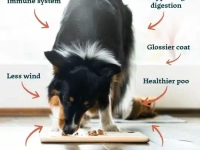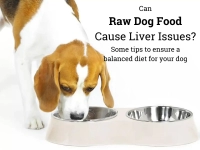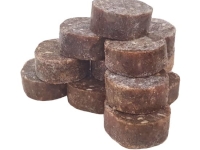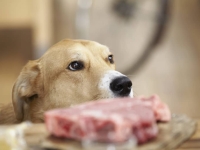Raw Dog Food for Labrador Retrievers: A Nutritional Guide
In This Article...
THE OVERVIEW...
Labrador Retrievers are known for their friendly nature and boundless energy. Providing them with a balanced diet is key to their long-term health and vitality. A raw food diet can be an excellent option for Labradors, offering natural, species-appropriate nutrition that supports their active lifestyle.
Best Diet for Labrador Retrievers
A raw diet, often called the BARF (Biologically Appropriate Raw Food) diet, mimics what dogs would eat in the wild. This approach focuses on whole, unprocessed foods, ensuring Labradors receive high-quality proteins, healthy fats, and essential vitamins and minerals.
Raw feeding is beneficial because it eliminates artificial preservatives and fillers found in many commercial dog foods. Additionally, it promotes a shinier coat, healthier skin, better digestion, and stronger teeth. For a complete guide to raw feeding, check out our article on how to choose raw food for your dog.
Nutritional Guidelines
Labradors should consume about 2-3% of their ideal body weight in raw food daily. For a 30 kg adult Labrador, this equates to 600-900 grams per day. A balanced raw diet typically includes:
- 70% muscle meat
- 10% raw edible bone
- 7% vegetables
- 5% liver
- 5% other secreting organs
- 2% seeds or nuts
- 1% fruit
Providing variety in protein sources is essential to ensure your Labrador receives a full spectrum of amino acids. Options like chicken, beef, lamb, venison, and fish can be rotated throughout the week. For high-quality raw meal options, consider our Ultimate Raw Dog Food Mix or Lamb & Salmon Medallions.
Transitioning to a Raw Diet
Switching your Labrador to a raw diet should be done gradually over 7–10 days. Begin by incorporating small amounts of raw food into their usual meals, slowly increasing the ratio while reducing kibble. This gradual transition allows their digestive system to adjust, minimizing the risk of gastrointestinal upset.
If you’re transitioning a small dog to raw, read our complete guide to raw food transitions. For Labradors, adding digestive enzymes or probiotics can help ease the switch and promote gut health. Always ensure fresh water is available, as raw-fed dogs may drink less than kibble-fed dogs due to higher moisture content in raw food.
Common Health Issues in Labradors
Labradors are generally healthy, but they can be prone to:
- Hip & Elbow Dysplasia – Genetic conditions that affect joint health.
- Obesity – Labradors love food and are prone to overeating.
- Ear Infections – Their floppy ears can trap moisture, leading to infections.
- Progressive Retinal Atrophy (PRA) – A degenerative eye disease.
- Exercise-Induced Collapse – A genetic condition affecting stamina.
A balanced raw diet can help manage weight and reduce inflammation, supporting overall health. Learn more about how raw food can improve your dog’s health.
Additionally, feeding raw meaty bones like beef neck bones helps maintain dental health by naturally scraping away plaque and tartar. Omega-rich foods such as salmon can support skin and coat health, reducing itching and shedding.
Exercise Recommendations
Labradors require at least an hour of exercise daily to stay healthy. Activities like swimming, running, and fetch are excellent for maintaining joint health and preventing obesity.
For Labradors who enjoy socializing, enrolling them in doggy daycare can provide both physical exercise and mental stimulation. If you’re unsure about daycare, read about the pros and cons of doggy daycare.
Interactive toys, agility training, and puzzle feeders can also keep their minds engaged while preventing destructive behaviors caused by boredom. If your Labrador is still a puppy, early socialization is crucial, and bringing your puppy to doggy daycare can be a great way to develop social skills.
Conclusion
A raw food diet can be highly beneficial for Labradors, providing them with the nutrients needed for an active, healthy life. By feeding high-quality raw meals and ensuring proper exercise, you can help your Labrador thrive. Explore our range of raw dog food options to get started today!
If you’re unsure about mixing raw and kibble, read our expert advice on feeding raw and dry food together. For more in-depth resources on raw feeding and canine health, visit our blog.
Frequently Asked Questions about Labradors and Raw Dog Food
Yes, a raw diet can be safe and beneficial for Labradors when properly balanced. It should include muscle meat, organs, bones, and essential nutrients. Consulting with a veterinarian or canine nutritionist is recommended to ensure your Lab gets a well-rounded diet.
A raw diet may improve coat health, increase energy levels, enhance digestion, strengthen the immune system, and promote healthier teeth and gums. Many owners also notice reduced allergies and less waste in their dog’s stool.
Yes, Labradors can eat raw chicken, including raw meaty bones like chicken wings or necks. However, it’s crucial to source high-quality, fresh meat and introduce it gradually to prevent digestive issues. Avoid cooked bones, as they can splinter and cause harm.
Start by introducing raw food gradually over 7–10 days. Begin with a single protein source, like chicken, and slowly add variety over time. Monitor your Lab’s digestion and adjust portions as needed. Some dogs may experience mild digestive changes during the transition.
Avoid feeding cooked bones, excessively fatty meats, and toxic foods like onions, garlic, grapes, chocolate, and macadamia nuts. Additionally, ensure raw fish is fresh and safe to avoid parasites, and limit high-fat cuts to prevent pancreatitis.



